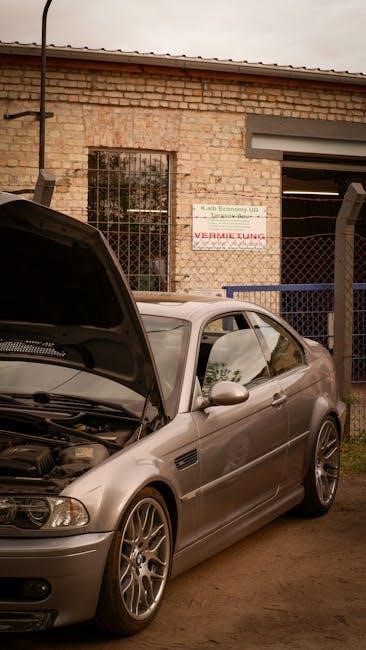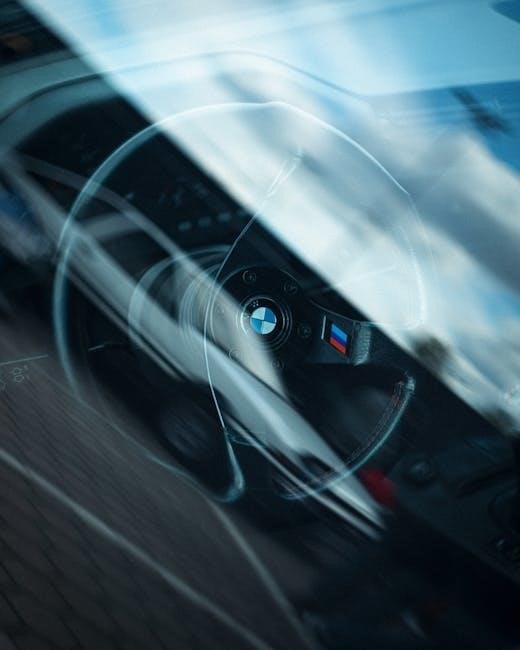The E46 M3 SMG to manual conversion is a popular modification for enthusiasts seeking improved driving dynamics and reliability. This process involves replacing the problematic SMG transmission with a traditional manual setup‚ offering better control and reduced maintenance costs. Ideal for those dissatisfied with the SMG’s performance‚ the conversion enhances the driving experience while potentially increasing the car’s resale value. It requires careful planning‚ specialized tools‚ and expertise to ensure a seamless transition to a three-pedal setup‚ making the M3 a true driver’s car.
1.1 Overview of the E46 M3 and the SMG Transmission
The BMW E46 M3 is a high-performance variant of the E46 3 Series‚ renowned for its powerful inline-6 engine and rear-wheel-drive layout. Produced from 1999 to 2006‚ it was offered with a 6-speed manual or the controversial SMG (Sequential Manual Gearbox) transmission. The SMG‚ while innovative‚ has faced criticism for its reliability issues‚ high maintenance costs‚ and less-than-smooth shifting. Many owners have opted to replace the SMG with a traditional manual transmission to enhance driving engagement and reliability.
1.2 Why Convert from SMG to Manual?

Converting from SMG to manual offers several advantages‚ primarily enhanced reliability and driving engagement. The SMG transmission‚ while innovative‚ often suffers from costly repairs‚ particularly with the pump and hydraulic system. Additionally‚ many drivers find the SMG’s shifting characteristics less satisfying compared to a traditional manual. Switching to a manual transmission eliminates these issues‚ providing a more tactile and rewarding driving experience. It also reduces long-term maintenance costs and appeals to purists who prefer a classic three-pedal setup‚ making the E46 M3 a more enjoyable and reliable performance car.
1.3 Brief History of the SMG Transmission in the E46 M3
The SMG (Sequential Manual Gearbox) transmission was introduced by BMW in the E36 M3 and later refined as SMG-II in the E46 M3. Designed to combine the efficiency of a manual with the convenience of an automatic‚ it used an electro-hydraulic system for clutch and gear actuation. While innovative‚ the SMG-II faced criticism for its abrupt shifting and reliability issues‚ particularly with the hydraulic pump and sensors. Its complexities led to high maintenance costs‚ prompting many owners to opt for manual conversions‚ restoring the driving experience to a more traditional and reliable setup.

Key Considerations Before Starting the Conversion
Evaluate the complexity‚ budget‚ and personal driving goals. Assess if the conversion aligns with your expertise‚ financial capacity‚ and desired driving experience to ensure a successful outcome.
2.1 Assessing the Complexity of the Conversion
Assessing the complexity of the E46 M3 SMG to manual conversion is crucial. It involves mechanical and electrical modifications‚ such as replacing the transmission‚ clutch system‚ and wiring harness. Specialized tools and a lift are often required‚ making it challenging for novices. The process demands careful planning and technical expertise‚ especially when machining the bellhousing or integrating OEM components. While some kits simplify the process‚ DIY enthusiasts may still face hurdles. Consulting experienced mechanics or specialists is highly recommended to ensure a smooth transition and avoid costly mistakes.
2.2 Cost Estimates and Budgeting
The cost of an E46 M3 SMG to manual conversion can vary widely‚ depending on the components and labor involved. Complete conversion kits‚ including a manual transmission‚ clutch system‚ and wiring harness‚ typically range from $4‚000 to $7‚000. Additional costs may include machining the bellhousing‚ specialized tools‚ and labor fees if hiring a professional. Budgeting for potential extras‚ such as upgraded drivetrain components‚ is also recommended. While the initial investment is significant‚ it can enhance the car’s performance and long-term value‚ making it a worthwhile expense for dedicated enthusiasts.
2.3 Determining if the Conversion is Right for You
Determining if an SMG to manual conversion is right for you involves evaluating your driving preferences and goals. If you value precise control and a more engaging driving experience‚ a manual setup may be ideal. Consider your budget‚ as the conversion can be costly. Additionally‚ assess the condition of your SMG system—frequent issues may justify the switch. For enthusiasts seeking a more authentic driving experience and potential long-term value appreciation‚ the conversion can be a rewarding choice. Reflect on your priorities to decide if the benefits outweigh the investment.

Necessary Components for the Conversion
The conversion requires a manual transmission‚ bellhousing‚ clutch system‚ flywheel‚ driveshaft‚ and wiring harness. Additional components include mounts‚ bearings‚ and hydraulic systems. Ensure all parts are compatible with the E46 M3 and meet OEM standards for reliability. Specialized tools and expertise may also be necessary for a successful swap. Proper selection of components is critical to achieving optimal performance and ensuring the conversion is both durable and seamless.
3.1 Manual Transmission and Bellhousing
The core of the conversion is the Getrag 420G 6-speed manual transmission‚ designed for the E46 M3. A compatible bellhousing must be sourced or machined to fit the manual setup. The bellhousing is crucial for aligning the transmission with the engine. Machining involves modifying the SMG-specific housing to accommodate the manual gearbox. Using OEM or high-quality aftermarket components ensures reliability and compatibility. Proper installation of the transmission and bellhousing is essential for smooth operation. This step sets the foundation for the entire conversion‚ ensuring proper gear engagement and drivetrain functionality.
3.2 Clutch System and Flywheel
The clutch system and flywheel are critical components in the E46 M3 SMG to manual conversion. Replacing the SMG-specific clutch with a manual-compatible setup ensures proper gear engagement. A genuine BMW or high-quality aftermarket clutch kit‚ including the clutch disc‚ pressure plate‚ and flywheel‚ is essential for reliability. The flywheel must be compatible with the new manual transmission to maintain smooth operation. Proper installation ensures precise control over gear shifts‚ enhancing both performance and longevity of the drivetrain. This step is vital for achieving a seamless driving experience.
3.3 Driveshaft and Mounts
The driveshaft and mounts play a crucial role in the E46 M3 SMG to manual conversion. The SMG-specific driveshaft may need modification or replacement to ensure compatibility with the manual transmission. High-quality mounts are essential to secure the new transmission properly‚ minimizing vibrations and ensuring smooth operation. Proper alignment and installation of these components are critical to avoid damage and maintain optimal performance. Using OEM or aftermarket components guarantees reliability and enhances the overall driving experience‚ making the conversion both durable and efficient.

3.4 Wiring Harness and Electronic Components
The wiring harness and electronic components are critical for a seamless SMG to manual conversion. A plug-and-play wiring harness is often used to adapt the manual transmission controls‚ eliminating the need for complex rewiring. The DME must be reprogrammed to recognize the manual transmission‚ ensuring proper engine and gearbox communication. Additionally‚ the CAN bus system may require updates to integrate the new components. Specialist tools and software are essential for these modifications. Proper installation ensures reliable operation and avoids potential electrical issues post-conversion.

Step-by-Step Guide to the Conversion Process
The conversion involves detailed steps‚ starting with vehicle preparation and tool assembly. Remove the SMG transmission‚ install the manual gearbox‚ and integrate the clutch system. Finalize with proper setup and thorough testing to ensure functionality and performance.
4.1 Preparing the Vehicle and Tools
Begin by gathering essential tools and ensuring a suitable workspace. Elevate the vehicle using a lift or jack stands for better access. Collect necessary tools like wrenches‚ sockets‚ and specialized equipment for transmission and bellhousing work. Safety gear‚ including gloves and goggles‚ is crucial. Drain fluids and prepare new ones for post-conversion use. Organize parts and tools neatly to maintain efficiency. Review repair manuals or online guides for specific instructions. Plan for adequate time‚ potentially several weekends‚ and consider professional help if needed. Create a checklist to ensure all components are ready‚ including the manual transmission kit‚ wiring harness‚ and electronic components. This preparation will streamline the conversion process and minimize unexpected issues‚ ensuring a smooth transition to a manual setup.
4.2 Removing the SMG Transmission
Removing the SMG transmission requires meticulous preparation and careful execution. Begin by lifting the vehicle onto jack stands to access the underside. Drain the transmission fluid to prevent spills. Disconnect the hydraulic lines and electronic connectors‚ taking care to label them for reinstallation. Remove the mounting bolts and support the transmission with a jack. Gently pull the transmission straight out‚ ensuring not to damage surrounding components. Set it aside securely. Consider enlisting help for this step due to the transmission’s weight. Once removed‚ prepare the bellhousing for the manual transmission conversion‚ ensuring proper fitment and alignment. This step is crucial for a successful conversion‚ so proceed with patience and attention to detail.
4.3 Installing the Manual Transmission
Installing the manual transmission begins with aligning it with the engine’s bellhousing‚ ensuring proper fitment. Secure the transmission using the provided mounting bolts‚ tightening them in a star pattern. Reconnect the driveshaft‚ making sure it is properly seated and secured. Refill the transmission fluid with the recommended specification. Check all connections‚ including the clutch system and wiring harness‚ for proper engagement. Finally‚ test the transmission by shifting through all gears to ensure smooth operation. Correct installation is critical for optimal functionality and to avoid future issues.
4.4 Final Setup and Testing
After installing the manual transmission‚ the final setup involves reconnecting all components and testing the system. Ensure the clutch pedal operates smoothly and the gearshift engages gears precisely. Bleed the hydraulic system to eliminate air bubbles and check for any fluid leaks. Perform a test drive to verify smooth shifting and proper clutch engagement. Monitor the transmission’s performance under various driving conditions to ensure reliability. Address any issues promptly to guarantee optimal functionality and a seamless driving experience.

Coding and Configuration
Coding and configuration are crucial steps post-conversion‚ ensuring the vehicle’s systems recognize the manual transmission. Reprogram the DME‚ update the CAN bus‚ and verify all functions for seamless operation.
5.1 Reprogramming the DME for Manual Transmission
Reprogramming the DME is essential to ensure compatibility with the manual transmission. The DME must be updated to recognize the new transmission type and adjust engine parameters accordingly. This involves reflashing the software to remove SMG-specific codes and integrate manual transmission logic. Without proper DME reprogramming‚ the engine may not function optimally‚ leading to issues like incorrect throttle response or gear synchronization problems. Professional tools and expertise are required for a successful DME reconfiguration.
5.2 Updating the CAN Bus System
Updating the CAN Bus system ensures seamless communication between the manual transmission and other vehicle components. The CAN Bus must recognize the new transmission type and adapt its signaling protocols. This update is crucial for proper functionality‚ as the SMG and manual transmissions operate on different communication parameters; Without updating the CAN Bus‚ the car may experience issues like erratic gear shifts or faulty sensor readings. A specialized tool is required to reflash the system and ensure all modules work harmoniously with the manual setup.
5.3 Ensuring Proper Functionality Post-Conversion
After completing the conversion‚ thorough testing is essential to ensure all systems function correctly. This includes checking the clutch operation‚ gear engagement‚ and electronic connections. The CAN Bus system must be validated to confirm proper communication between components. A test drive under various conditions helps identify any issues that may have arisen during the conversion. Additionally‚ monitoring the car’s behavior over time ensures long-term reliability and performance‚ making the vehicle a true driver’s machine with enhanced control and responsiveness.
The E46 M3 SMG to manual conversion enhances driving experience‚ offering better control and increased value. It’s a rewarding modification for enthusiasts‚ making the M3 a true driver’s car.
6.1 Benefits of the Manual Conversion
Converting the E46 M3 from SMG to manual offers numerous benefits‚ including enhanced driver engagement and control. The traditional three-pedal setup provides a more immersive driving experience‚ allowing enthusiasts to connect deeply with the vehicle. Additionally‚ a manual transmission often reduces maintenance costs compared to the complex and failure-prone SMG system. This conversion can also increase the car’s desirability and resale value‚ as manual M3s are highly sought after by purists and collectors. The switch simplifies the drivetrain‚ making it more reliable and enjoyable for years to come.
6.2 Potential Drawbacks and Considerations
While the manual conversion offers significant advantages‚ it also presents challenges. The process requires substantial disassembly‚ making it labor-intensive and time-consuming. Costs can be high‚ as specialized tools and components are needed. Additionally‚ the conversion may alter the car’s original factory specifications‚ potentially affecting its resale value for some buyers. The complexity of reconfiguring systems like the wiring harness and CAN bus can also pose technical difficulties. Furthermore‚ the loss of SMG-specific features‚ such as paddle-shift functionality‚ may dismay some enthusiasts. These factors require careful consideration before proceeding with the conversion.
6.3 Final Recommendations for Prospective Converters
Prospective converters should thoroughly research and budget for the process‚ considering both time and financial investments. Professional assistance is highly recommended due to the complexity of the conversion. Ensure all components are genuine or OEM-quality to maintain performance and resale value. Additionally‚ consider the car’s mileage and condition to determine if the conversion is worthwhile. Finally‚ weigh personal driving preferences against the potential loss of SMG-specific features. For enthusiasts seeking a more engaging drive‚ the manual conversion can be highly rewarding.